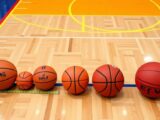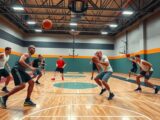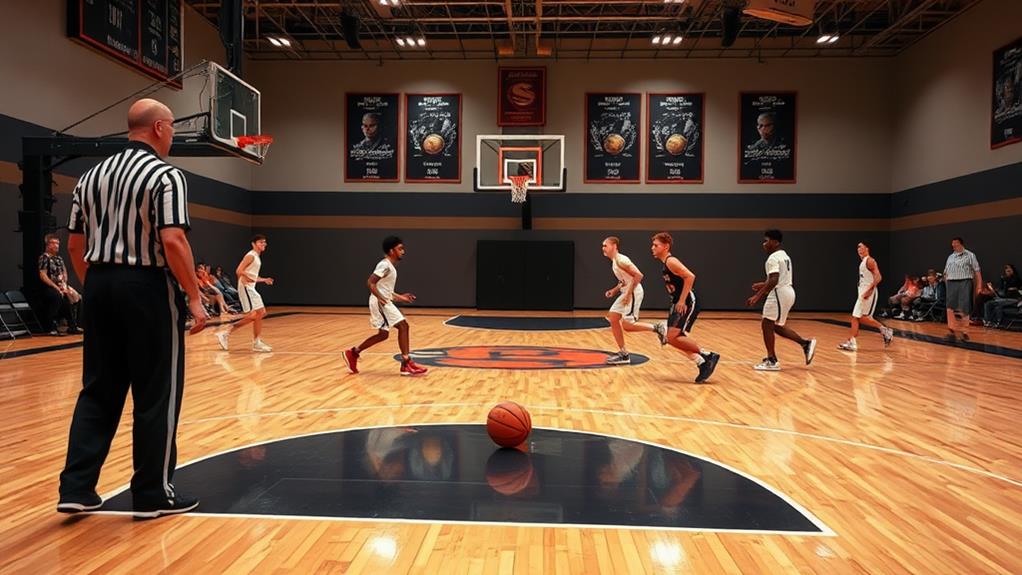
What Is Backcourt in Basketball? Rules and Regulations
November 15, 2024In basketball, the backcourt is the area behind the midcourt line. Knowing the rules about backcourt violations is essential to avoid turnovers. A violation occurs if you return to the backcourt after crossing the midcourt line, unless your team hasn't established frontcourt status yet. You must advance the ball past midcourt within 10 seconds after an inbound pass. Touching the ball in the backcourt after securing frontcourt status results in a violation too. Understanding these key points will help you navigate the game more effectively, and there's plenty more to explore on this topic.
Definition of Backcourt Violation
A backcourt violation is a common occurrence in basketball that happens when an offensive player, after crossing the midcourt line, returns to the backcourt without establishing both feet in the frontcourt. This violation can lead to a turnover, giving the opposing team possession of the ball at the nearest sideline or baseline to where the violation occurred.
To avoid a backcourt violation, you must maintain your frontcourt status, which means both feet and the ball need to be in the frontcourt. If you're an offensive player who loses possession and the ball is batted into the backcourt by a defensive player, you can retrieve it without penalty.
However, if you fail to advance the ball past the midcourt line within 10 seconds after an inbound pass, you'll incur a separate 10-second violation. This is distinct from a backcourt violation but can also lead to a turnover.
Understanding the nuances of game dynamics, such as the offside rule, can help you maintain control and avoid unnecessary mistakes during gameplay. Remember, once you've established your position in the frontcourt, returning to the backcourt to retrieve the ball results in an over-and-back violation.
Understanding these rules can help you maintain control and avoid unnecessary mistakes during gameplay.
Key Rules and Regulations
Understanding key rules and regulations surrounding backcourt violations is essential for players and coaches alike. A backcourt violation occurs when an offensive player crosses the midcourt line into the frontcourt and then returns to the backcourt, resulting in a turnover. To avoid a ten-second violation, teams must advance the ball past the midcourt line within 10 seconds after an inbound pass.
Data analytics plays an important role in optimizing player movements, helping teams understand the implications of backcourt violations on their overall strategy and performance. Once both feet of an offensive player are established in the frontcourt, they can't touch the ball in the backcourt without committing an illegal backcourt violation.
However, if an offensive player fumbles the ball into the backcourt after a shot attempt, there's no penalty for a backcourt violation since neither team has control of the basketball at that moment. Additionally, defensive players can legally recover a ball that's been batted into the backcourt after a missed shot, as long as they'd no prior possession.
Familiarizing yourself with these rules will help you navigate the game more effectively and avoid costly mistakes during play. Always keep these regulations in mind to maintain possession and capitalize on scoring opportunities. Understanding these performance metrics will further enhance your gameplay and decision-making on the court.
Examples of Backcourt Violations
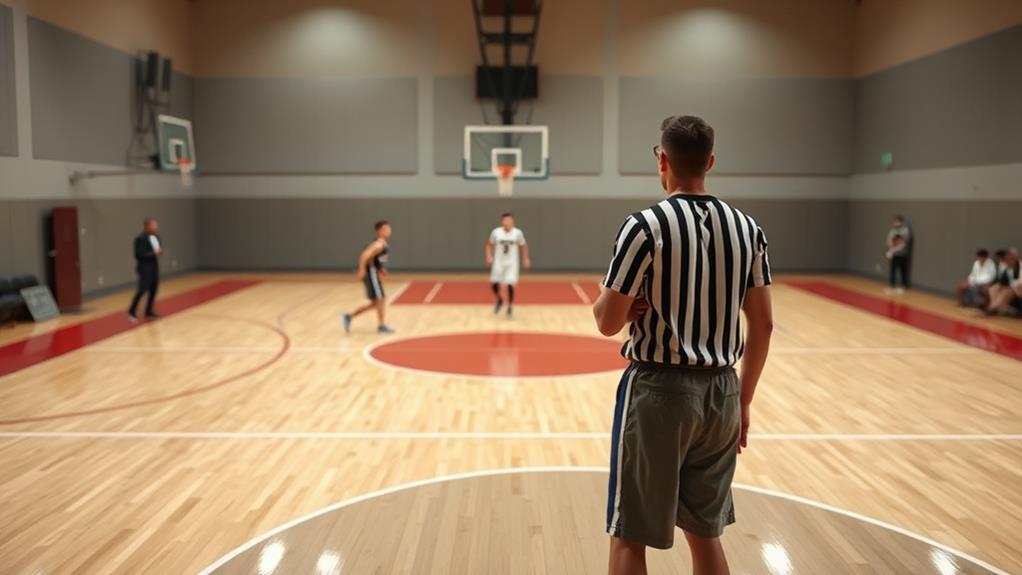
Backcourt violations can greatly impact a game, and recognizing specific scenarios helps players avoid costly mistakes. Understanding the importance of maintaining possession is essential, as these violations can shift momentum.
Here are some common examples of backcourt violations:
- If an offensive player crosses the midcourt line into the frontcourt but then returns to the backcourt without having established frontcourt status, it's a backcourt violation.
- When a player fumbles the ball into the backcourt, they can't touch it first. If the opposing team gains possession, this results in a backcourt violation.
- A frontcourt player passing to a teammate in the backcourt after both feet have established frontcourt status counts as a backcourt violation.
- If you jump from the frontcourt to catch a pass but land in the backcourt, it doesn't negate the violation.
Additionally, once the basketball has been established in the frontcourt, an offensive player can't retrieve the ball in the backcourt. This scenario leads to an over and back violation, which can seriously swing the momentum of the game.
Being mindful of these violations can help maintain possession and enhance your team's performance.
Legal Actions Misinterpreted as Violations
Misconceptions about legal actions in basketball can lead to unnecessary turnovers and confusion on the court. For instance, if an offensive player dribbles in the backcourt and then bounces the ball into the frontcourt without stepping over the midcourt line, they won't incur a backcourt violation. This understanding is essential as teams increasingly rely on analytics to inform defensive strategies and make quick decisions during gameplay.
After a missed shot, if an offensive player bats the ball into the backcourt, it's not a violation since team control hasn't been established post-shot. Additionally, if you jump from the frontcourt to catch an inbound pass but land in the backcourt, you won't face a violation as long as you didn't establish possession in the frontcourt first.
Fumbling an inbound pass into the backcourt also doesn't lead to penalties since team control isn't established. Lastly, when a defensive player tips the ball into the backcourt, and you, as an offensive player, retrieve it, no backcourt violation occurs.
Understanding these legal actions can clarify your play and help you avoid unnecessary mistakes, ensuring you maintain possession and control throughout the game.
Factors Determining Backcourt Status
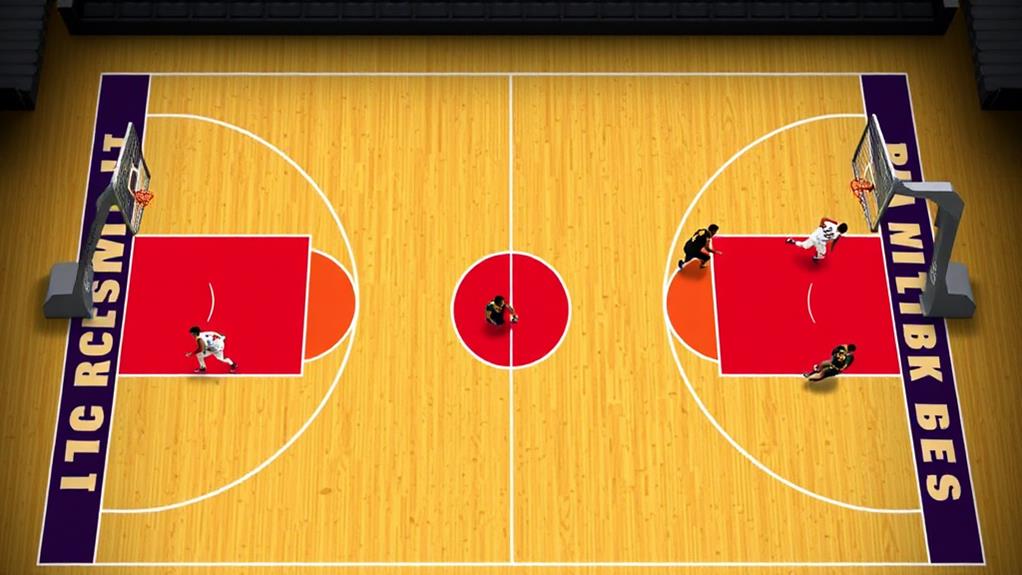
When playing basketball, knowing the factors that determine backcourt status is essential for avoiding violations. Your understanding of the ball and player positioning can make a significant difference during the game.
Centers, much like backcourt players, must be aware of their positioning and the dynamics of the court, as their role often involves quick decisions and maintaining control over the game flow, which can highlight their versatility.
Here are some key factors to evaluate:
- A player obtains backcourt status when any part of their body touches the backcourt, which is the half of the court opposite their offensive basket.
- The ball's status—backcourt or frontcourt—depends on the last player to touch it and their position at that moment.
- To shift the ball legally from backcourt to frontcourt, both the player and the ball must completely cross the midcourt line; just dribbling or stepping over isn't enough.
- Once a player establishes frontcourt status with both feet and the ball, they can't return to the backcourt without incurring a backcourt violation.
Staying aware of your team's position and ensuring you understand the ball's status can help prevent costly turnovers.
Always keep these factors in mind to maintain your advantage on the court!
Factors Determining Frontcourt Status
Achieving frontcourt status is vital for maintaining offensive momentum in basketball. You can verify a player's frontcourt status when both feet touch the frontcourt while controlling the ball.
Understanding event rules is significant, as it guarantees that you can exploit scoring opportunities effectively. It's important that the ball also crosses the midcourt line completely, as its status changes only then. If you lose control during the shift from backcourt to frontcourt, you risk committing a backcourt violation.
Remember, the last player to touch the ball determines its status. If a player in the backcourt touches the ball after it's established in the frontcourt, the ball reverts to backcourt status, which can disrupt your offensive flow. This means you need to be mindful of the control you have over the ball during the play.
Understanding these factors helps you avoid turnovers and maintain possession. Always be aware of where you're on the court and confirm that you and the ball make it to the frontcourt before attempting your offensive plays.
Staying sharp about these distinctions can greatly enhance your gameplay and keep the momentum in your favor.
Special Cases and Exceptions
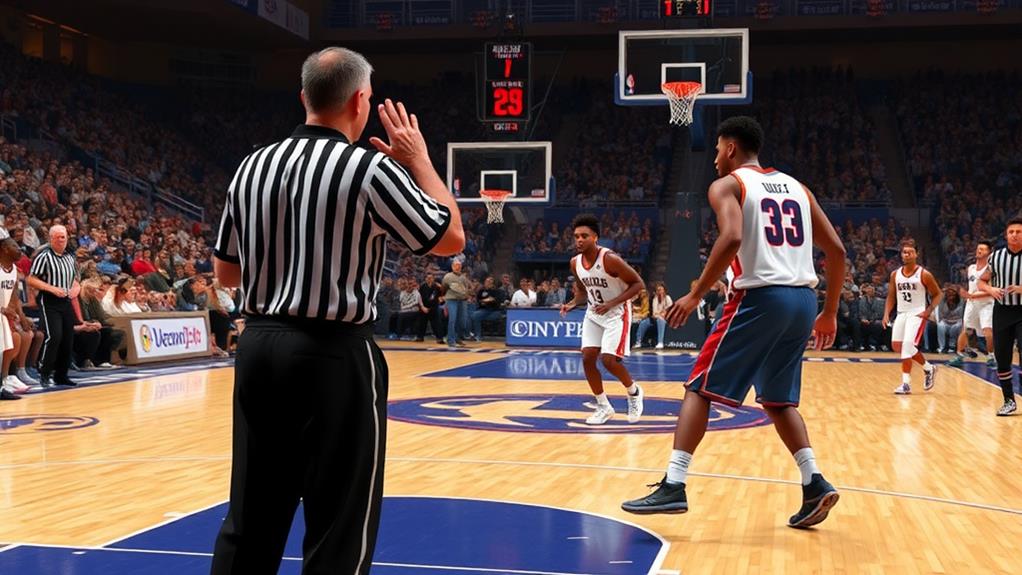
In basketball, understanding special cases and exceptions surrounding backcourt violations can greatly impact your gameplay. Knowing when a backcourt violation occurs or doesn't can save your team from unnecessary turnovers.
International basketball tournaments, like the FIBA World Cup, often highlight the importance of adhering to the rules, showcasing how teams adapt to different game scenarios, including the evolution of playing styles.
Here are some important scenarios to keep in mind:
- If an offensive player jumps from the frontcourt to catch the ball, they won't incur a violation even if they land in the backcourt, as long as they'd valid frontcourt status when they caught it.
- Should an offensive player fumble an inbound pass into the backcourt, they can regain possession without committing a violation due to the lack of established control during the inbound.
- When a player bats the ball into the backcourt after a missed shot, no violation happens because the ball doesn't gain backcourt status when control is lost.
- If a player retrieves a tipped ball in the backcourt that was deflected by a defensive player, a backcourt violation isn't called since the offensive team didn't previously establish control.
Understanding these special cases and exceptions will keep your team on the right side of the rules!
Teaching Strategies for Players
To help your players master the backcourt rules, start by encouraging them to develop an inner clock that keeps track of the 10-second rule.
Understanding the significance of this rule is essential for effective gameplay, just as Nera White's exceptional skills were critical in her era.
Incorporate drills that focus on effective ball advancement while emphasizing proper spacing and positioning on the court.
Inner Clock Development
Developing an inner clock is essential for basketball players, as it enhances their ability to make quick decisions under pressure. Understanding time constraints is vital when you're an offensive player, especially when you need to advance the ball past midcourt.
Here are some effective strategies you can use to develop this skill:
- Practice the 10-second rule: Regular drills help you gauge the time you have to cross midcourt and avoid a backcourt violation.
- Use audible counts during scrimmages: This technique allows you to understand when to make faster decisions while dribbling the basketball.
- Emphasize spacing and ball movement: Focusing on these aspects can help you avoid panic situations when under pressure.
- Engage in high-pressure scenario drills: Simulating these situations reinforces your ability to manage your inner clock while maintaining control of the ball.
Additionally, regularly reviewing game footage can help you identify timing mistakes. This practice will enhance your instincts, allowing you to operate more effectively during live play.
Effective Ball Advancement
Effective ball advancement is essential for maintaining offensive momentum in basketball. As an offensive player, you need to manage your backcourt status effectively, guaranteeing you advance the ball past midcourt within the 10-second rule. Developing an inner clock will help you make quicker decisions and keep the shot clock in mind.
In practice, focus on drills that emphasize spacing and ball movement. This will help you advance the ball while maintaining proper positioning on the court. Clear communication among teammates is critical; use audible cues to signal when to push up the court or slow down based on defensive pressure.
Integrating fast break scenarios in practice will enhance your quick decision-making skills. This allows you to shift the ball from backcourt to frontcourt under pressure, developing your instincts for effective ball advancement.
Additionally, make sure you're proficient in fundamental skills like dribbling, passing, and catching. These skills are essential for executing effective ball advancement techniques during games.
Spacing and Positioning
Spacing and positioning are essential elements in basketball that can considerably impact your team's offensive flow. When you effectively manage spacing, you create opportunities for ball movement and reduce defensive pressure.
Here are some strategies to improve your spacing and positioning:
- Maintain Proper Distance: Keep adequate space between players to facilitate passing and reduce turnovers.
- Awareness of the Half-Court Line: Always monitor your distance from the half-court line to avoid backcourt violations and guarantee you've crossed into the frontcourt.
- Utilize Angles: Move strategically in the backcourt using angles to create passing lanes and better positioning against defenders.
- Communicate Constantly: Call out your movements and positions to guarantee everyone is on the same page, making it easier to maintain control of the ball during shifts.
Importance of Backcourt Rules
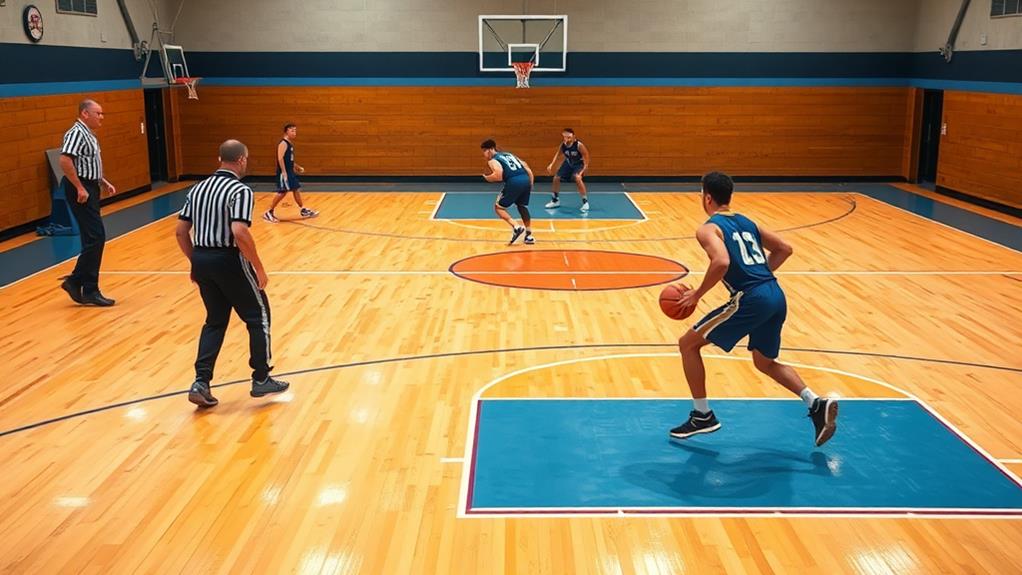
Understanding backcourt rules is essential for any player or coach aiming to maintain a competitive edge in basketball. These rules are important for ensuring a fair balance between offensive and defensive play.
For the offensive team, the 10-second rule mandates that they must advance the ball past midcourt within 10 seconds after gaining ball possession. This promotes quick decision-making and effective ball movement, which is critical for maintaining offensive flow.
Additionally, the evolution of basketball equipment design, with innovations in lightweight materials and improved grip technology, can greatly enhance a player's ability to execute plays efficiently, allowing for sharper cuts and quicker changes on the court material innovation and lightweight design.
Failing to comply with the 10-second rule results in a backcourt violation, leading to a turnover and giving the opposing team possession of the ball. Such turnovers can disrupt your team's momentum and increase pressure from the defense, making it harder to execute your strategy.
Understanding these rules can help you avoid costly mistakes that hinder your team's performance.
The evolution of backcourt rules, especially since the introduction of the 10-second rule in 1954, highlights the need for quick changes and discourages time-wasting tactics.
Conclusion
To summarize, understanding backcourt rules is essential for every basketball player and fan. You might think these rules are too complicated, but visualizing the court can help. Picture the midcourt line as a dividing line: once you cross it with possession, you've entered the frontcourt. If you then retreat past that line with the ball, you've committed a backcourt violation. By grasping these concepts, you'll enhance your gameplay and enjoy the sport even more!

